You’ve probably read countless project management guides, covering tasks, goals, and workflows. But what about the invisible factors that derail projects? Poor resource management is a hidden cost for many organizations, leading to burnout, delays, and inefficiencies that ripple through every team.
Let’s zoom into this critical discipline, uncover its importance, and explore how platforms like monday work management can help you master resource management with ease and efficiency.
What is resource management?
Resource management involves planning, scheduling, and allocating resources such as people, skills, money, or tools in preparation for an upcoming project. The goal is to manage your resources appropriately to deliver value to your business.
Typically, project managers divide available resources into two distinct categories.
Tangible resources are anything that you can see or touch. This could include labor, machinery, property, software, or money.
Intangible resources are more abstract. An intangible resource might be intellectual property (like a technology patent), an idea, or a particular set of skills required to get the job done.
These include organizational culture, which sets the tone for collaboration and productivity, and knowledge-sharing practices that prevent silos and foster innovation. Strong professional relationships within and across teams are another intangible resource, enabling smoother communication and better problem-solving.
These unseen assets are just as important as tangible resources, often driving long-term success by building a foundation of trust and shared expertise.
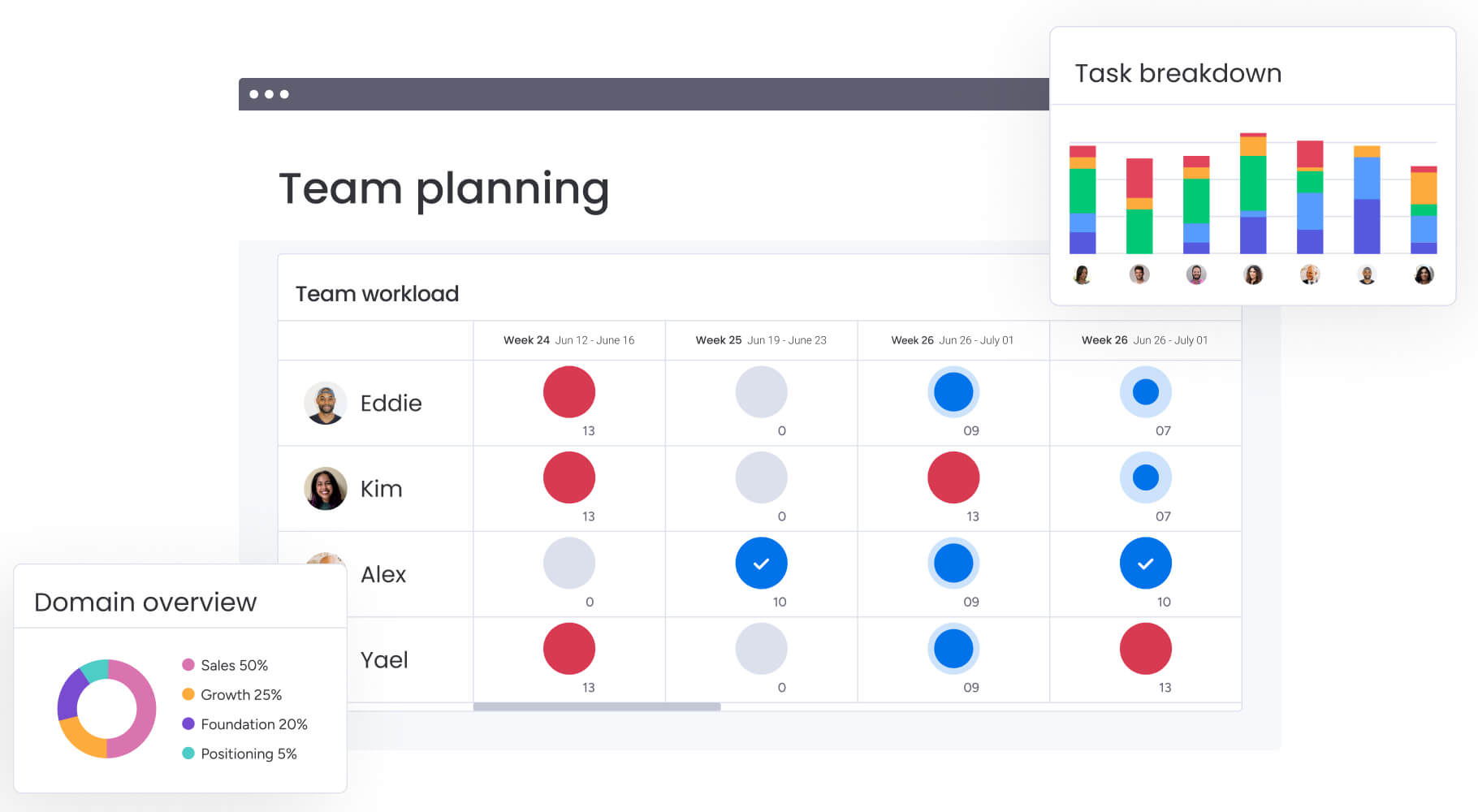
Why is resource management important?
Every project depends on effective resource allocation, but poor management can lead to measurable setbacks.
Reducing budget overruns is one of the clearest benefits of resource planning, as it prevents unnecessary expenses and maximizes financial efficiency.
Improving resource utilization means teams can work smarter, completing tasks faster while minimizing waste. With the right approach, project managers can align available skill sets with project needs, creating a balance that keeps teams productive and engaged.
These results go beyond just meeting deadlines—they drive profitability and strengthen client trust.
Why is resource management important in project management?
Resource management is critical for planning and assessing what is needed to complete a project while balancing resource constraints with project goals. This efficient approach reduces waste and allows for the reuse and recycling of financial resources throughout the project lifecycle.
Imagine developing a new software application for a client with a 3-month timeline. At the start, tasks are allocated based on team skills and availability, with a focus on resource utilization to maintain progress.
If a team member is unavailable, tasks can be reassigned to another colleague without disrupting the schedule. When additional resources like a replacement laptop are required, preparation avoids delays and keeps the project on track.
This strategic approach delivers the app on time and within budget and protects profit margins. Strong resource management impresses clients, helps secure more future projects, and builds a foundation for long-term success.
What are the benefits of resource management?
Resource management might seem like an extra step in an already full project process, but it’s essential for making the most of your team, tools, and time. Here’s how effective resource management drives better outcomes:
Prevents unexpected setbacks
59% of professional services companies cite the “inability to predict project resource needs” as a top challenge. With a clear understanding of available resources and their best uses, potential problems can be addressed before they derail progress.
Reduces burnout and supports productivity
Over-allocated resources and uneven workloads lead to stress and inefficiency. Resource management distributes tasks evenly within your workload planning, keeping your team engaged and productive without feeling overwhelmed.
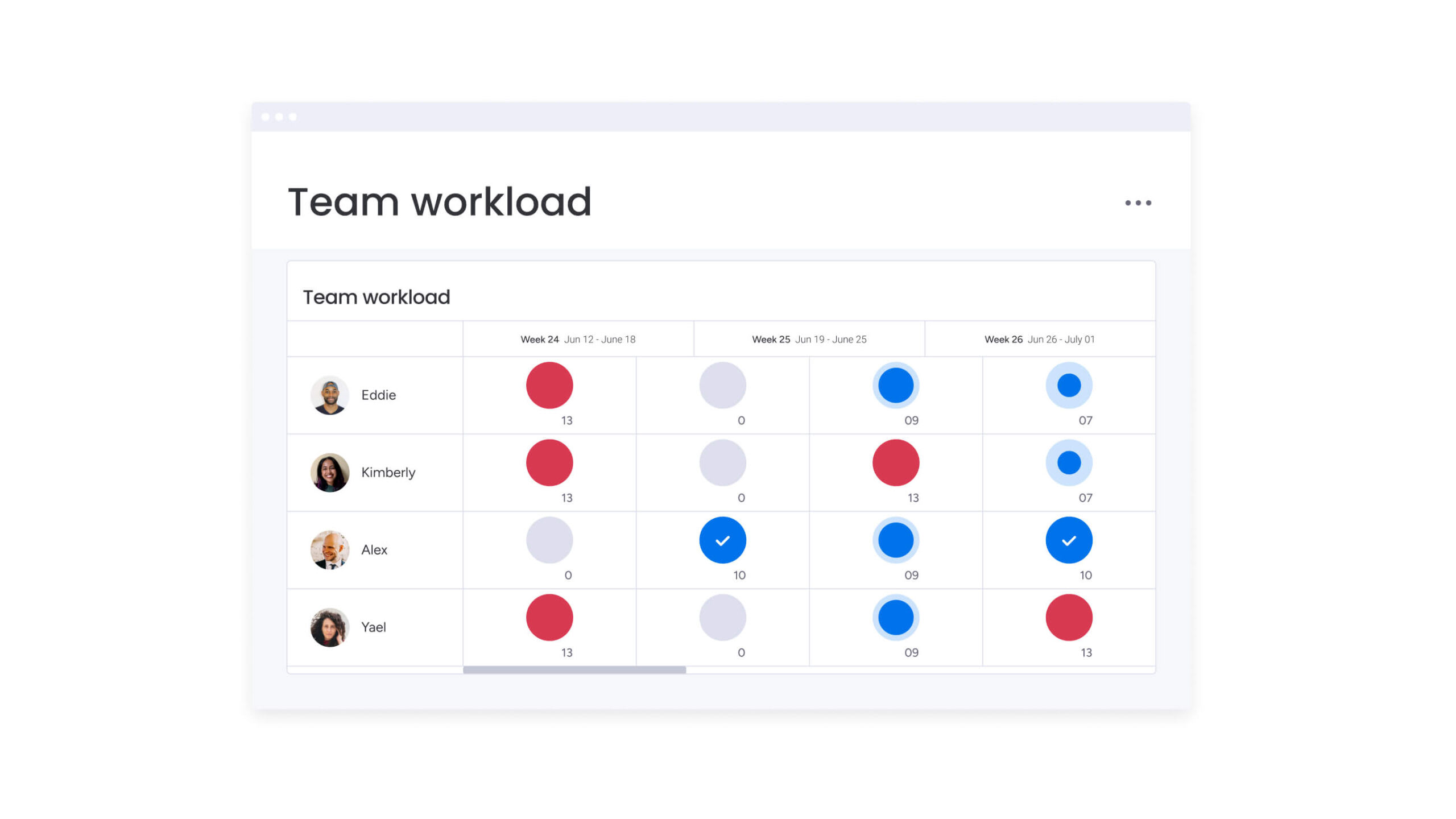
Improves team effectiveness
Allocating resources strategically makes it easier to meet deadlines and reduce waste. Teams with the right support are more likely to finish projects on time and within budget.
Provides a safety net when challenges arise
When a project falls short of goals due to resource limitations, a well-managed plan demonstrates that every effort was made with what was available. This transparency strengthens trust with stakeholders.
Builds operational efficiency
Tracking resource allocation and usage highlights how teams consume resources. These insights enable better planning for future projects and ongoing improvements to operational planning and workflows.
Boosts productivity with centralized visibility
Resource management brings all project details into one space. Seeing who’s working on what, when, and where creates clarity, helping your team stay aligned and avoid confusion.
Balances workloads for sustained performance
Avoid overburdening team members or leaving talent underutilized. Dynamic workload balancing helps maintain steady performance across teams, preventing burnout and boosting efficiency.
Aligns skills and tasks for better outcomes
Matching team members’ skills and availability with project needs improves collaboration and performance. A well-aligned team works more efficiently and delivers better results.
Anticipates hiring needs and skill gaps
Forecasting staffing requirements helps address gaps in skills or capacity before they become obstacles. Proactive planning supports team growth and ensures readiness for upcoming challenges.
Refines project estimates through time tracking
Accurate tracking of time spent on tasks provides valuable data for improving future estimates. Realistic timelines lead to smoother execution and fewer missed deadlines.
The hidden costs of poor resource management
Resource mismanagement quietly impacts productivity, morale, and project success, creating challenges that often go unnoticed until they escalate. Addressing these issues as part of your resource management process can transform outcomes.
- Missed opportunities: Inefficient utilization of resources leaves teams scrambling to address immediate problems instead of focusing on innovation or long-term goals. A lack of resources often forces compromises on quality or scope, limiting growth potential.
- Frequent rework: Misaligned tasks and skill sets lead to mistakes that require time-consuming corrections. Poor capacity planning contributes to these inefficiencies, diverting energy from current projects.
- Frustration for stakeholders: Delayed timelines and unfulfilled commitments strain relationships with clients and internal teams. Consistently missing deadlines due to overallocation of resources or poor resource management reduces stakeholder confidence.
- Low employee satisfaction: Poor resource management often leads to overwork, inconsistent workloads, and frustration, all of which harm employee satisfaction. Balanced resource allocation creates a more equitable environment where team members feel supported and valued. When employees have the tools and time to excel, they’re more likely to stay engaged and productive, contributing to better project outcomes and a positive workplace culture.
These hidden costs impact employee satisfaction and actual costs, eroding trust across the organization. Taking a proactive approach to resource planning helps teams focus on what matters, improve project outcomes, and foster a culture of collaboration and growth.
4 steps to create a resource management plan
A well-defined resource management process sets the foundation for project success. These steps guide you in managing resources effectively and maximizing team potential:
Step 1: Define your project goals
Start by clarifying what success looks like for your project. Break down objectives into clear, actionable milestones and identify the resources—people, tools, and budget—needed at each stage. This clarity sets the roadmap for effective execution.
Step 2: Take stock of your resources
Conduct an inventory of all available resources, both tangible and intangible. Consider team skills, available equipment, and financial allocations. Understanding what you have at your disposal helps avoid overreliance on limited resources or misaligned efforts.
Step 3: Match resources to tasks
Allocate resources strategically, aligning tasks with team members’ skill sets and availability. This step prevents bottlenecks and balances workloads, creating a smoother flow of progress. For instance, leverage resource visualization tools to identify underused or overburdened assets.
Step 4: Adapt plans as challenges arise
Monitor resource utilization in real time to identify and address shifts in priorities or unforeseen constraints. Flexibility is key—adjusting timelines or reallocating resources keeps the project moving forward even when obstacles arise.
What are the different techniques of resource management?
Optimizing resource management involves applying specific techniques to maintain efficiency throughout the project lifecycle:
- Resource forecasting: Predict future needs based on project scope and organizational trends to minimize waste and keep execution on track.
- Resource planning: Determine what resources are needed, when they’re needed, and how they’ll be used to support project milestones.
- Resource allocation: Deploy resources effectively by analyzing their availability and aligning them with project priorities to maximize output.
- Resource scheduling: Plan when and where resources will be used to ensure smooth workflows and avoid conflicts.
- Resource leveling: Balance workloads by redistributing underused resources or extending timelines to optimize efficiency.
- Resource smoothing: Prevent workload peaks and valleys by spreading tasks evenly across timelines without compromising project deadlines.
These techniques provide the structure to refine processes, respond dynamically to challenges, and achieve better results with the resources at hand.
What are 5 common types of resources in project management?
Project management involves juggling different resource types that drive success. Generally speaking, as a project manager (or resource manager), there are five different types of project management resources that will occupy your time.
1. People
Team members, often referred to as staff or human resources, are the backbone of any project. Managing people includes recruitment, tracking performance metrics, and balancing workloads.
Payroll and HR tools simplify managing tasks like compensation and compliance while providing insights into resource availability. When team performance dips or conflicts arise, taking corrective actions keeps the project on track and maintains momentum.
monday work management can be used as a comprehensive resource management software, with WorkForms to capture job applications, a Time Tracking Widget to keep an eye on your team’s workload, and many different HR-specific templates to help you get started in a quick and organized fashion.
2. Material resources
Materials are the consumable resources needed to complete tasks, such as building supplies, packaging materials, or hardware components. Tracking material usage helps avoid waste and reduces the risk of delays caused by shortages. Visualizing material availability through dashboards or project views allows teams to plan better and adapt to changing needs.
Our Map Views enable everybody to see precise material locations and share labels for different material types on your workflow templates. You can also choose from Gantt, Kanban, Work Calendar, and Dashboard views to instantly see a resource status at any given moment.
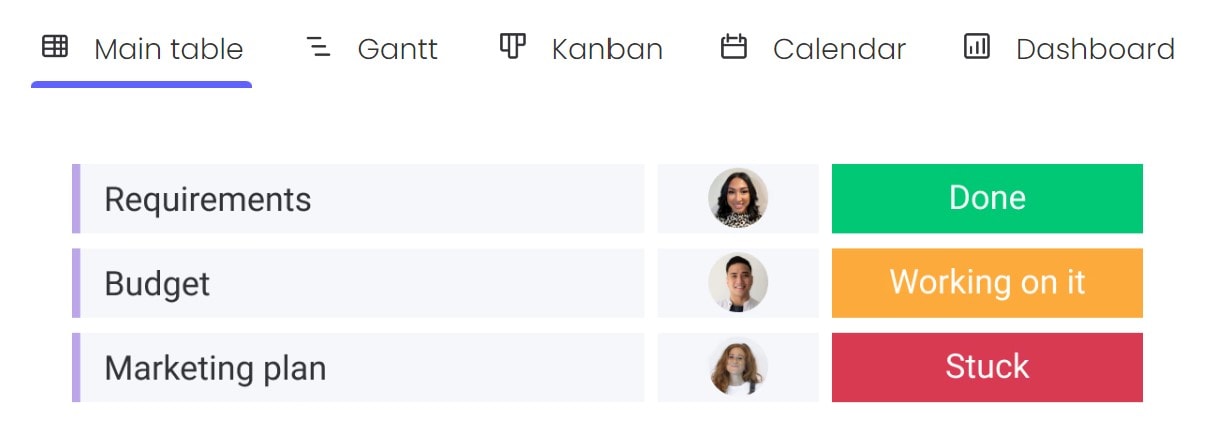
3. Equipment
Equipment differs from materials in that it isn’t consumed during a project. These tools, whether physical machinery or digital licenses, play a key role in execution. Tracking usage metrics, such as maintenance schedules or operational hours, helps optimize performance. Projects that incorporate real-time equipment tracking are better positioned to avoid downtime and resource conflicts.
4. Money
Financial resources, including budgets and payroll, underpin every project. Keeping a clear view of expenses and labor costs supports better financial planning and protects profit margins. Payroll and HR integrations streamline the process of tracking workforce-related costs, making it easier to allocate funds where they’re needed most without overspending.
5. Time
Time is one of the most finite resources in project management. Creating realistic timelines, tracking progress, and identifying areas for corrective actions help keep projects moving forward. Aligning team schedules with resource availability reduces bottlenecks and helps teams hit deadlines with confidence. Tracking metrics like task completion rates provides actionable insights for optimizing time management.
Best practices for resource management
If you’re just starting to work on your resource management processes, here are our three top tips:
1. Plan ahead
Just 2.5% of companies complete every project on time. If you want to be one of them, start trying to figure out your resource requirements as early as possible in the project, to avoid those last-minute scrambles.
2. Balance your team’s workloads
Don’t overload your team – that’s how mistakes get made. In fact, more than half of employees have begun to feel signs of burnout. To avoid putting too much pressure on your team, break large tasks down into smaller tasks and aim to distribute them fairly across multiple team members.
3. Be flexible
Good resource management is based on a strong awareness that change happens. KPMG found that two-thirds of project managers recognized this, and had a formal project change management process in place. So, when planning and allocating resources for your project, expect the unexpected. Be prepared that you’ll probably need to tweak your resource allocation as the project goes on.
Examples of successful resource management
Understanding how effective resource management works in practice can inspire better planning and execution for your own projects. Here are two examples that showcase its transformative impact:
- Software development team: A growing software company faced a critical deadline for launching a new product. The team used workload tracking tools to monitor resource utilization and identified bottlenecks early in the development cycle. Tasks were reallocated strategically to balance workloads and address skill gaps, allowing the team to stay on schedule. As a result, the product launched on time, avoiding costly delays and protecting the company’s reputation for reliability and innovation.
- Nonprofit event planning: A nonprofit organization was preparing for its largest annual fundraiser but struggled with limited resources and a tight timeline. The team implemented a detailed resource allocation plan that optimized the use of vendors and volunteers. By prioritizing high-impact areas and reallocating underutilized resources, they reduced overall vendor costs and maximized every dollar raised. The event exceeded fundraising goals, demonstrating the power of proactive resource management in achieving financial and organizational objectives.
Proactive resource management is about so much more than meeting deadlines. It’s a way to optimize team efforts, achieve project goals, and foster long-term success.
Resource management jobs
If you’re considering a career in resource management, you’ll find opportunities across industries that rely on efficient resource allocation to drive success. Here are a few roles where resource management expertise shines:
- Resource manager: These specialists focus on aligning resources with project goals, ensuring teams have the tools, skills, and time they need to succeed. They often work closely with project managers to optimize productivity and mitigate risks.
- Operations manager: Overseeing the big picture, operations managers streamline processes and resource use across the organization, balancing immediate needs with long-term strategy.
- Project manager: Project managers juggle multiple hats, combining resource management with task delegation to deliver results efficiently. Their ability to plan and allocate resources effectively directly impacts project success.
Resource management roles are key to keeping teams organized, motivated, and on track—and with the right skills and tools, you can make a big impact in these positions.
How to become a resource manager
Becoming a resource manager involves developing the right mix of experience, skills, and tools to lead teams and projects to success. Follow these steps to start your journey:
Step 1: Gain relevant experience
The best way to build a strong foundation is by gaining hands-on experience in roles like project coordination, operations support, or even as part of a project team. These roles help you understand workflows, resource dependencies, and team dynamics.
For example, supporting a project team with scheduling or allocation tasks can prepare you for managing resources across multiple projects in the future.
Step 2: Develop essential skills
Resource managers rely on a combination of technical and interpersonal skills. Focus on building:
- Leadership skills to inspire and guide teams toward shared goals.
- Communication skills to clearly articulate resource needs and project updates.
- Analytical skills to make data-driven decisions and forecast future needs.
Soft skills like adaptability and problem-solving will also set you apart as you navigate the complexities of resource planning and management.
Step 3: Master resource management tools
The right tools can make or break your ability to manage resources efficiently. Platforms like monday work management help you streamline planning, scheduling, and allocation, giving you real-time insights into resource availability and usage.
With features like Workload view, time tracking, and dashboards, monday work management equips you with the capabilities you need to thrive as a resource manager.
Step 4: Earn certifications
Professional certifications boost your credibility and demonstrate your expertise. Popular certifications include:
- PMP (Project Management Professional): ideal for those managing resources within complex projects.
- CAPM (Certified Associate in Project Management): a great option for those starting their careers.
Specialized training in resource management software, like monday work management, can also give you a competitive edge.
With the right experience, skills, and tools, you’ll be well-equipped to succeed as a resource manager — and make a meaningful impact on the teams and projects you lead.
Manage your resources efficiently with monday work management
monday work management makes the challenging balancing act of resource management easier. We help you put all your resources front and center, so you can see what’s used, how long for, and who’s responsible in real-time.
Our user-friendly, no-code work management platform lets you:
- Plan, schedule, and allocate resources to adapt to changing priorities, with resource-centric displays that give you the precise status of the resource as a snapshot.
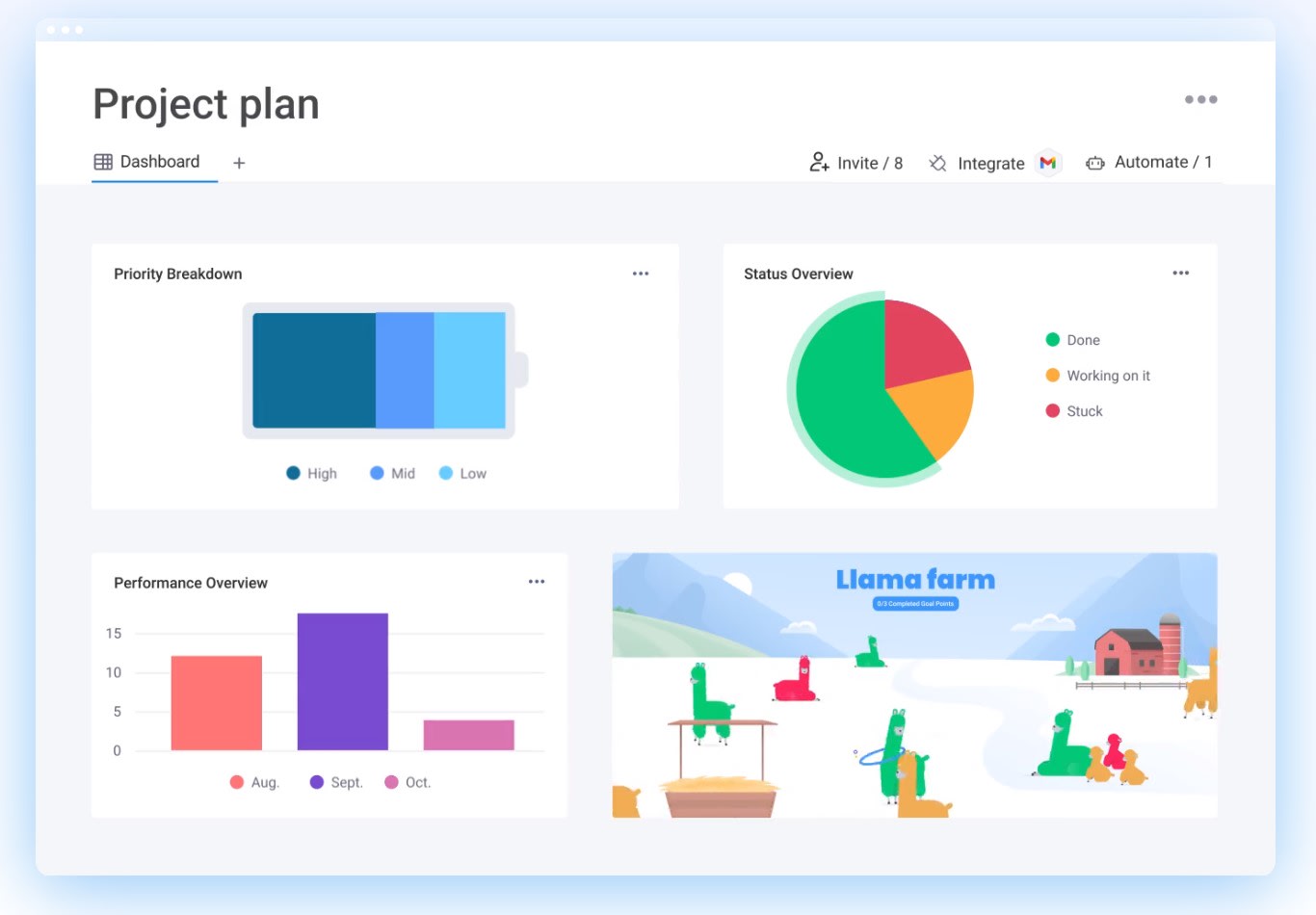
- Use the Workload view to easily visualize and track the hours each team member takes to work on each project task. By doing this, you can gain a quick overview of over and under-utilized resources and manage your team’s time proactively. You can also use this view to track resources and equipment.
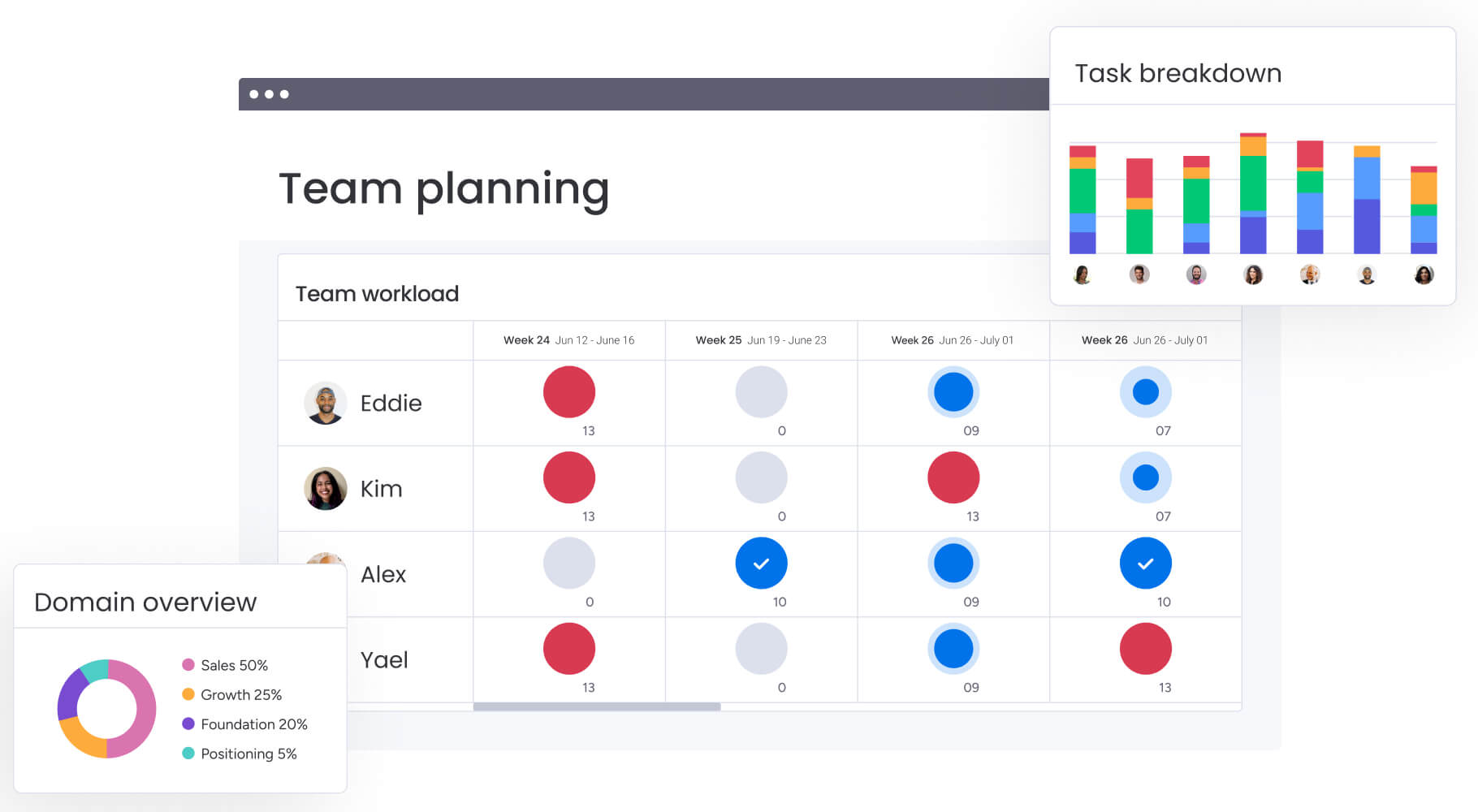
- Keep an eye on your project budget and track your expenses with our financial overview displays.
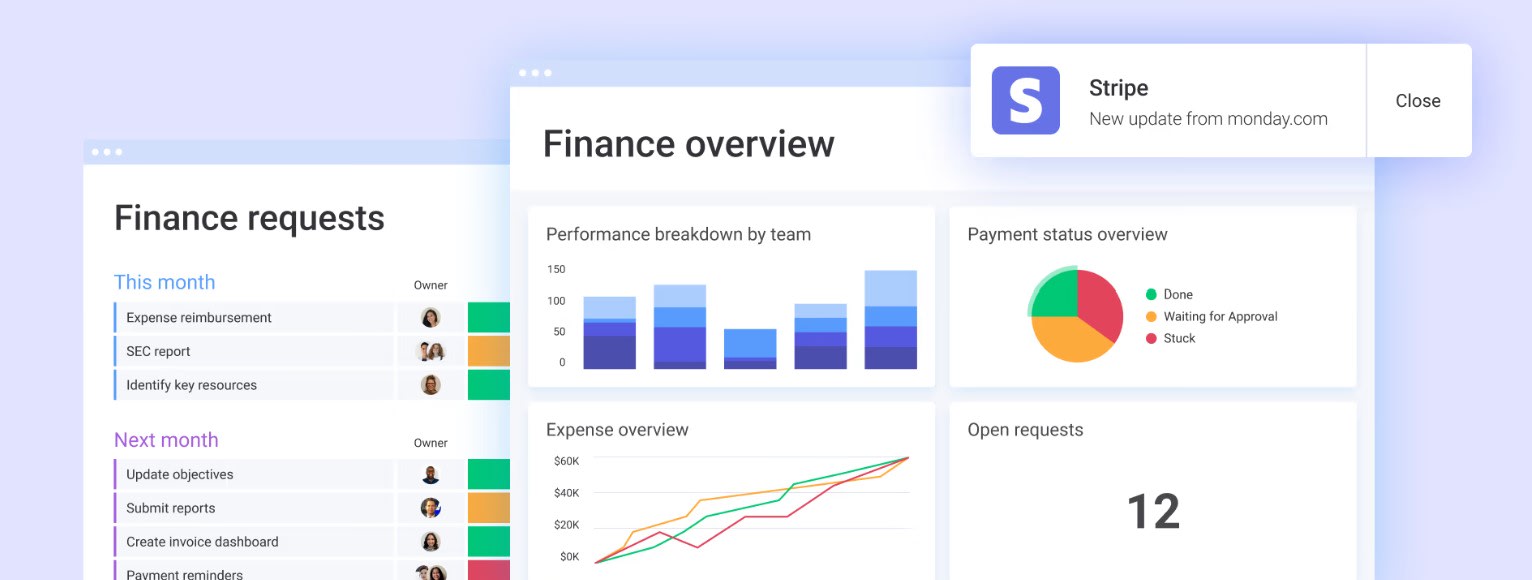
Kickstart resource management planning with monday work management
Resource management is the backbone of successful project execution. Planning, scheduling, and allocating resources effectively helps teams stay on track and avoid common challenges. Poor resource management can lead to delays, burnout, and budget overruns, but taking a proactive approach keeps projects moving forward.
Addressing inefficiencies and aligning resources with goals unlocks your team’s full potential. With clear workflows and a focus on collaboration, resource management drives better results, builds trust, and supports long-term growth.
FAQs
How do I know if my resource management process is working?
Effective resource management is reflected in your team’s ability to meet project deadlines, stay within budget, and maintain balanced workloads. Use metrics like resource utilization, task completion rates, and employee satisfaction surveys to evaluate and improve your process. A steady workflow without frequent rework or delays is a strong indicator of success.
What’s the difference between resource management and capacity planning?
While both focus on resources, resource management is about allocating what’s available to current projects, while capacity planning looks at your long-term ability to meet future demands. Capacity planning involves forecasting, addressing skill gaps, and preparing for upcoming challenges, whereas resource management focuses on immediate project needs.
How can resource management improve team collaboration?
Resource management creates transparency by centralizing information about workloads, tasks, and priorities. When everyone knows who’s working on what and when, collaboration becomes easier. Teams can align on goals, avoid duplicated efforts, and address challenges together more effectively.
Can resource management help with cost control?
Absolutely. Effective resource management minimizes overspending by aligning resources with project goals and timelines. Tracking actual costs against budgets, reallocating underused resources, and planning ahead for bottlenecks helps you stay financially efficient.
What’s the first step to improve resource management at my organization?
Start with an audit of your current processes. Assess how resources are currently allocated, identify any inefficiencies, and gather input from your team on their challenges. From there, implement a system to track and manage resources, such as workload tools or dashboards, to create a foundation for ongoing improvements.
 Get started
Get started 
